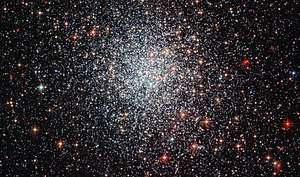NGC 1783
NGC 1783 (also known as ESO 85-SC29) is a globular cluster within the Dorado constellation and part of the Large Magellanic Cloud, a satellite dwarf galaxy of the Milky Way. It is one of the brightest globular clusters in the LMC as viewed from Earth. It was discovered in 1835 by John Herschel. The compiler of the New General Catalogue, John Louis Emil Dreyer, described this cluster as "considerably bright, large, round, very gradually pretty much brighter middle, mottled but not resolved."[2]
| NGC 1783 | |
|---|---|
 Hubble Space Telescope image of NGC 1783[1] | |
| Observation data (J2000 epoch) | |
| Constellation | Dorado [2] |
| Right ascension | 04h 59m 08.6s[3] |
| Declination | −65° 59′ 15.8″[3] |
| Distance | 160 Kly[4] (49 Kpc[4]) |
| Apparent magnitude (V) | 10.93[3] |
| Apparent dimensions (V) | 5.3' x 4.7'[3] |
| Physical characteristics | |
| Other designations | ESO 85-SC29 |
References
- "A youthful cluster". ESA/Hubble Picture of the Week. Retrieved 24 August 2015.
- "New General Catalogue Objects: NGC 1750 - 1799". Retrieved 2015-09-20.
- "NGC 1783". SIMBAD. Centre de données astronomiques de Strasbourg. Retrieved 2015-09-20.
- "NED results for object NGC 1783". NASA/IPAC Extragalactic Database. Retrieved 2015-09-20.
This article is issued from Wikipedia. The text is licensed under Creative Commons - Attribution - Sharealike. Additional terms may apply for the media files.